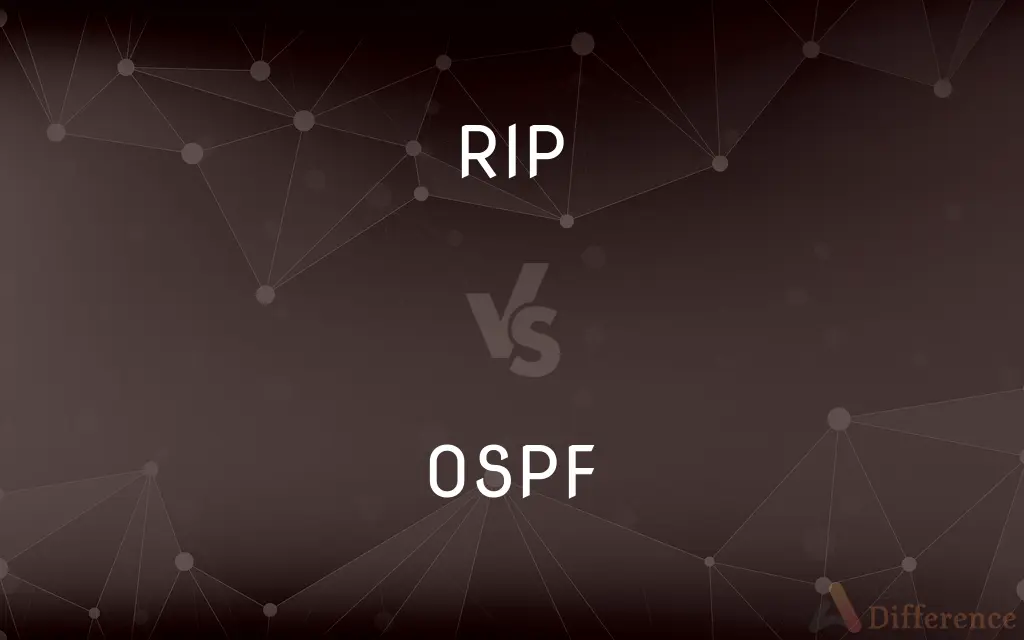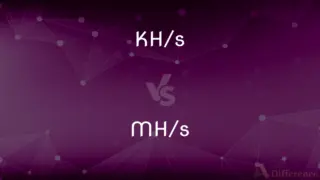RIP vs. OSPF — What's the Difference?
By Tayyaba Rehman & Urooj Arif — Published on February 2, 2024
RIP (Routing Information Protocol) uses distance-vector routing, simpler, slower convergence. OSPF (Open Shortest Path First) is a link-state protocol, more complex, faster convergence.

Difference Between RIP and OSPF
Table of Contents
ADVERTISEMENT
Key Differences
RIP and OSPF Routing Mechanisms: RIP (Routing Information Protocol) is a distance-vector routing protocol, using hop count as its primary metric. It is simpler and widely used in smaller networks. OSPF (Open Shortest Path First), on the other hand, is a link-state protocol that uses a more complex algorithm to calculate the shortest path based on various factors like bandwidth and link cost.
Scalability of RIP and OSPF: RIP is less scalable due to its limited hop count, typically up to 15, making it unsuitable for large networks. OSPF excels in scalability, efficiently managing large and complex networks with its ability to partition into areas and hierarchical routing.
Convergence Speed in RIP and OSPF: OSPF offers faster convergence compared to RIP. The convergence, which refers to the time a network takes to react to changes, is slower in RIP due to its periodic updates and time-based approach. OSPF quickly adapts to network changes using immediate state updates.
RIP and OSPF Network Overhead: RIP generates more network overhead in large networks due to its regular full routing table updates. OSPF reduces overhead by sending only incremental updates and using multicasting for routing information exchange.
Administrative Control in RIP and OSPF: In RIP, there is minimal administrative control over the path selection. OSPF provides more control over the routing process, allowing administrators to define the cost of each link, influencing the path selection.
ADVERTISEMENT
Comparison Chart
Routing Algorithm
Distance-vector
Link-state
Metric
Hop count (max 15 hops)
Cost based on bandwidth, link type, etc.
Convergence Speed
Slower
Faster
Scalability
Suitable for smaller networks
Suitable for larger, complex networks
Network Overhead
Higher in large networks
Lower due to incremental updates
Compare with Definitions
RIP
Rest in Peace
They wrote 'RIP' on the tombstone.
OSPF
Open Shortest Path First (Routing Protocol)
OSPF is used to find the most efficient route.
RIP
Rip (Tear)
She had to rip the envelope open.
OSPF
OSPF (Link-State Protocol)
The network's OSPF topology was complex.
RIP
Rip (Copy)
He decided to rip the CD to his computer.
OSPF
OSPF (Hierarchical)
OSPF allows for hierarchical network designs.
RIP
Rip (Fast Movement)
The car ripped down the street.
OSPF
OSPF (Dynamic Routing)
They implemented OSPF to improve network efficiency.
RIP
Rip (Strong Current)
Swimmers should be wary of the rip in the water.
OSPF
OSPF (Scalable)
OSPF was chosen for its scalability in large networks.
Common Curiosities
What does RIP stand for?
Routing Information Protocol.
What is the main limitation of RIP?
Its hop count limit and slower convergence.
How does RIP determine the best route?
By counting hops, up to 15.
How does OSPF choose the best path?
Based on link state and cost metrics.
What does OSPF stand for?
Open Shortest Path First.
Can RIP handle complex network topologies?
It struggles with very complex topologies.
What is the administrative distance of RIP?
Typically 120.
Is RIP suitable for large networks?
No, it's better for smaller networks.
Can OSPF handle rapid network changes?
Yes, it has fast convergence times.
Is OSPF good for large networks?
Yes, it's designed for scalability.
Can OSPF work with other routing protocols?
Yes, through route redistribution.
What type of algorithm does OSPF use?
A Dijkstra-based link-state algorithm.
Does RIP support load balancing?
Yes, but only over equal-cost paths.
What's a key feature of OSPF?
Its ability to segment into areas.
Does OSPF require more CPU/memory resources than RIP?
Yes, due to its complexity.
Share Your Discovery

Previous Comparison
Left Handed vs. Right Handed
Next Comparison
KH/s vs. MH/sAuthor Spotlight
Written by
Tayyaba RehmanTayyaba Rehman is a distinguished writer, currently serving as a primary contributor to askdifference.com. As a researcher in semantics and etymology, Tayyaba's passion for the complexity of languages and their distinctions has found a perfect home on the platform. Tayyaba delves into the intricacies of language, distinguishing between commonly confused words and phrases, thereby providing clarity for readers worldwide.
Co-written by
Urooj ArifUrooj is a skilled content writer at Ask Difference, known for her exceptional ability to simplify complex topics into engaging and informative content. With a passion for research and a flair for clear, concise writing, she consistently delivers articles that resonate with our diverse audience.
















































